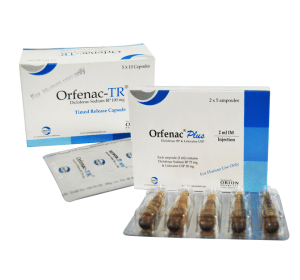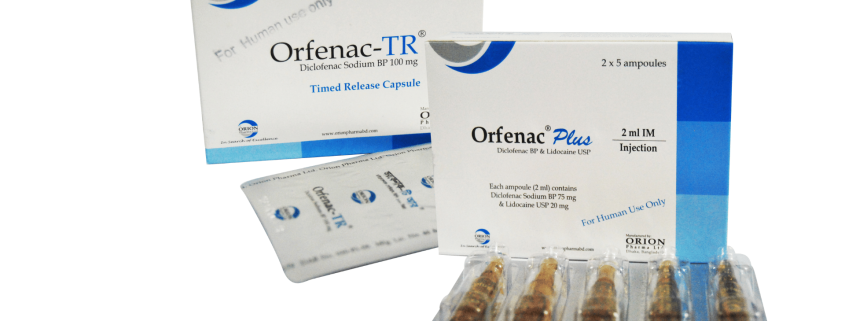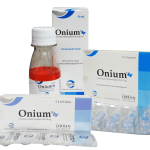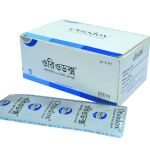Orfenac

NSAIDs : Diclofenac Sodium
Indication
i) Arthritic conditions : Rheumatoid arthritis, osteoarthritis, ankylosing spondylitis, acute gout.
ii) Acute musculoskeletal disorders such as periarthritis (e.g., frozen shoulder), tendinitis, bursitis.
iii) Other painful conditions resulting from trauma, including fracture, low back pain, sprains, strains, dislocations, orthopedic, dental and other minor surgery.
Orfenac plus injection also contains Lidocaine, which acts as a local anesthetic. Therefore, the possibility of pain at the injection site, which is most likely to occur after intramuscular injection of normal Diclofenac, is minimized if Orfenac plus injection is used.
Contraindication
Diclofenac is contraindicated to the patients with active or suspected peptic ulcer or gastrointestinal bleeding and hypersensitive to Diclofenac Sodium. Orfenac should not be given to patients who have experienced asthma, urticaria or other allergic type reaction after taking Aspirin or other NSAIDs.
Because of the presence of Lidocaine, Orfenac plus injection is also contraindicated for those patients who are hypersensitive to local anesthetics of the amide type, although the incidence is very rare. In patients with Adams-Stokes syndrome or with severe degrees of SA, AV, or intraventricular heart block in the absence of an artificial pacemaker this injection is also contraindicated.
Dosage & Administration
Orfenac -TR Capsule:
1 Capsule daily, preferably at meal times.
Children: 1-3 mg / kg body wt. daily in divided doses.
Elderly patients: In elderly or debilitated patients, the lowest effective dose is recommended.
Orfenac plus injection:
Adults: One ampoule once (or in severe cases, twice) daily by intramuscular injection.
Renal colic: One ampoule once daily intramuscularly. A further
ampoule may be administered after 30 minutes, if necessary.
The recommended maximum daily dose of Diclofenac is 150 mg , by any route.
The recommended maximum daily dose of Lidocaine is 200 mg.
Children : In juvenile chronic arthritis, 1-3 mg of Diclofenac/ kg body wt. daily in divided doses.
Side Effect
Orfenac is usually well tolerated. Patients may sometimes complain of epigastric pain, nausea, diarrhoea, vomiting, abdominal cramps, dyspepsia, flatulence, anorexia, dizziness or headache. These symptoms are often transient and disappear with continuation of medication. Peripheral edema and skin reactions such as rash and eczema have also been encountered. In very rare instances, injection site disorders may occur. In isolated cases, abscesses and local necrosis may occur. The adverse effects due to Lidocaine mainly involve the CNS, are usually of short duration, and are dose related. The CNS reactions may be manifested by drowsiness, dizziness, disorientation, confusion etc.
Drug Interaction
Drug interactions may occur with Lithium, Digoxin, Anticoagulants, Oral antidiabetic agents, Cyclosporin, Methotrexate, Quinolone Antimicrobials, Aspirin and Potassium-sparing diuretics.
Presentation
Orfenac-TR capsule: Box containing 5 x 10 capsules in blister pack.
Orfenac Plus Injection: Box containing 2 x 5 ampoules in blister pack.



